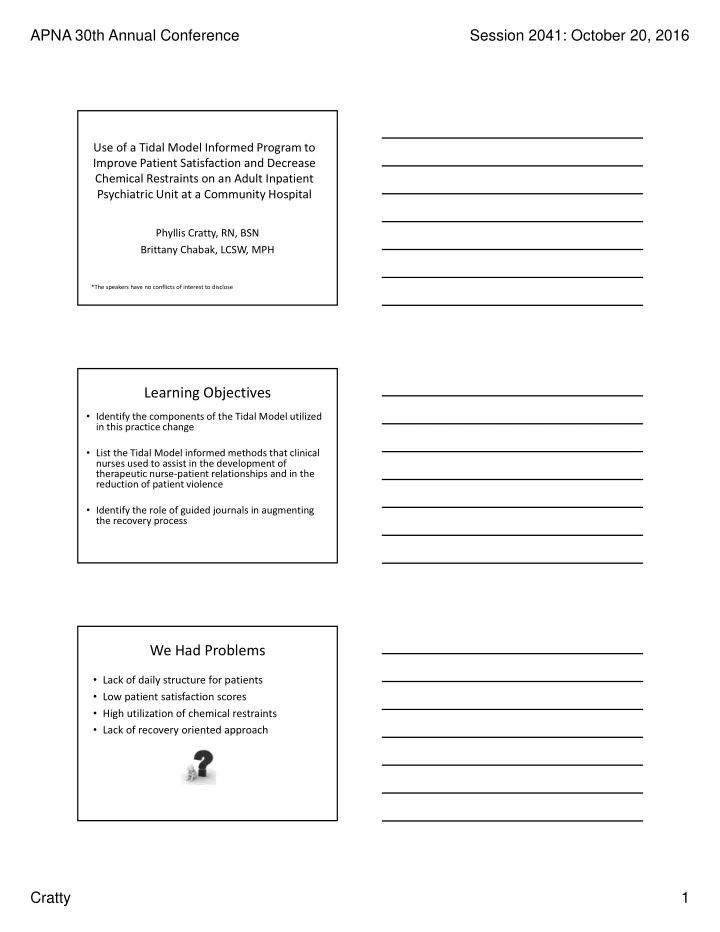

APNA 30th Annual Conference Session 2041: October 20, 2016 Use of a Tidal Model Informed Program to Improve Patient Satisfaction and Decrease Chemical Restraints on an Adult Inpatient Psychiatric Unit at a Community Hospital Phyllis Cratty, RN, BSN Brittany Chabak, LCSW, MPH *The speakers have no conflicts of interest to disclose Learning Objectives • Identify the components of the Tidal Model utilized in this practice change • List the Tidal Model informed methods that clinical nurses used to assist in the development of therapeutic nurse ‐ patient relationships and in the reduction of patient violence • Identify the role of guided journals in augmenting the recovery process We Had Problems • Lack of daily structure for patients • Low patient satisfaction scores • High utilization of chemical restraints • Lack of recovery oriented approach Cratty 1
APNA 30th Annual Conference Session 2041: October 20, 2016 Tidal Model • Recovery ‐ oriented approach designed for acute inpatient mental health settings • 3 main points – Importance of therapeutic relationship – Healing comes from telling our stories – Our lives are ever changing • Studies indicated – Decrease in patient aggression 1,2,3 – Decrease in physical restraints 1,2,3 – Increase in patient satisfaction 4 1 Gordon et al., 2005; 2 Lafferty & Davidson, 2006; 3 Berger, 2006; 4 Cook et al., 2005 Image: http://tejasforyou.blogspot.com/2012/02/sagar ‐ kusumagraj.html Incorporation of Tidal Model Elements • Centrality of the patient’s narrative – Guided journal – Recovery ‐ focused 1:1 • Emphasis on therapeutic patient ‐ staff relationships • Types of groups – Solutions, Recovery, Information Role of Nurses • Recovery focused one ‐ to ‐ ones – Listening to a patient’s story; their “lived experience” – Empathizing and understanding – Empowering patient to make changes • Facilitate medication groups • Assist patients in the use of guided journals • Enforce unit structure “It is the relationship that heals” – Yalom, 1980 Cratty 2
APNA 30th Annual Conference Session 2041: October 20, 2016 Guided Journals • Developed by our staff with feedback from patients • Empowers patients by giving them space to tell and own their story • Engages patients in treatment outside of groups • Main components: – Daily thought ‐ provoking questions – Recovery plan – Daily goals – Medications – Resources Outcome Measures • Patient satisfaction scores Highly Agree Neutral Disagree Highly agree disagree The group discussions were helpful • Patient Aggression Records Date Time Patient Information Medication Diagnosis Hadol Bipolar Disorder Ativan Psychotic Disorder Place Sticker Here Schizophrenia Thorazine Dementia Other IDD/MR Personality D/O Other ______ Outcomes: Patient Satisfaction • Data – 8 months pre and 10 months post implementation – 2 “post months” were outliers and excluded (N ₁ = 8; N ₂ = 8) • Analysis – Independent two ‐ sample t ‐ test assuming unequal variances – Testing H 0 : µ 1 = µ 2 H A : µ 1 ≠ µ 2 ; α <0.05 Cratty 3
APNA 30th Annual Conference Session 2041: October 20, 2016 Outcomes: Patient Satisfaction • Findings – 18% increase in patients marking “Highly agree” and “Agree” on surveys – P= 0.0001; statistically significant suggesting rejection of H 0 Patient Satisfaction 100 Percentage of Positive Patient Satisfaction Ratings 90 80 Pre 70 Post 60 50 1 2 3 4 5 6 7 8 Month Outcomes: Chemical Restraints • Data – 5 months pre and 6 months post (N ₁ = 5; N ₂ = 6) – IM/PRN Now medications administered between the hours of 8am ‐ 5pm weekdays only – Only first 5 PRN/IM medications per patient per admissions counted in data • Analysis – Independent two ‐ sample t ‐ test assuming unequal variances – Testing: H 0 : µ 1 = µ 2 H A : µ 1 ≠ µ 2 α <0.05 Outcomes: Chemical Restraints • Findings – 40% decrease in IM/PRN Now medications weekdays 8am – 5pm – P=0.009 – Statistically significant suggesting rejection of H 0 Cratty 4
APNA 30th Annual Conference Session 2041: October 20, 2016 Discussion of Findings • Logic Model of 2013 for Tidal Model Project – Proposed a 15% increase in patient satisfaction ratings – Proposed a 20% decrease in IM/PRN Now meds • Must also consider other variables – Small sample sizes – Increased staff ‐ patient ratio during day – Time of year • Can this change be sustained? Recent Program Changes • Expansion of group program – Evenings and weekends – Aides and nurses facilitating more groups • Journals in every patient’s Welcome Packet Future Implications • Additional nursing staff – More time to develop relationships with patients – Float nurse on evening and night shifts – Greater presence on the unit • Increase regulation of group topics • On ‐ going training and assessment of adherence to program components Cratty 5
APNA 30th Annual Conference Session 2041: October 20, 2016 “Mental health nurses have great opportunities to impact positively on the health and well ‐ being of people they provide care for through using the ‘nurse ‐ patient’ relationship as a therapeutic tool to promote recovery and help people live the lives they want to lead” – McAndrew et al., 2014 Questions? Cratty 6
Recommend
More recommend